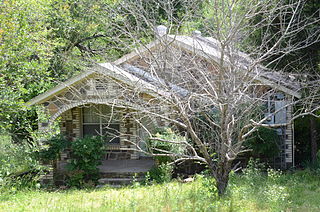
Spears House is a historic house at 1235 United States Route 65 in Greenbrier, Arkansas. It is a single-story frame structure, faced in rock veneer with cream-colored brick trim. Built about 1946, it is basically Craftsman in style, with the stylistic of the regionally prominent African-American mason Silas Owens, Sr. seen in the use of cream-colored brick, arched openings, and herringbone stone patterns on the walls.
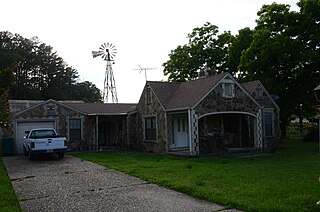
The Merritt House is a historic house at 139 North Broadview in Greenbrier, Arkansas. It is a single story wood frame structure, finished with a masonry veneer, with an irregular plan featuring a variety of roof gables. The exterior is finished in sandstone with cream-colored brick trim. The main entrance is set under a deep front porch, whose front has a broad flat-topped arch, with a gable above that has a louver framed in brick. The house was built by Silas Owen, Sr., a local master mason, in 1948 for Billy Merritt. It was built using in part stone from a house built by Owen for Merritt's father, which had recently been torn down.

The Sherman and Merlene Bates House is a historic house at the southeast corner of Dawson and Echo Streets in Hardy, Arkansas. It is a single story wood frame house finished in sandstone veneer, with a gable roof. The main facade has a projecting front gable section, which has a picture window on the left and the main entrance on the right. A period garage, finished with the same stone, stands behind the house. The house was built in 1947 for Sherman Bates, owner of a local bulk fuel oil facility, and is a high-quality local example of a post-World War II stone house.

The Bear Creek Motel is a historic motel on United States Route 65 in Bear Creek Springs, Arkansas. It is a single T-shaped stone and concrete building, built in 1936 to replace a wood-framed tourist accommodation that had burned down. The building has a distinctive wave-shaped concrete roof, intended to lure travelers off the road, and houses five guest rooms and an office. The wave shape is continued in the guest rooms, which have barrel-vaulted ceilings, and are also finished in concrete and stone veneer.
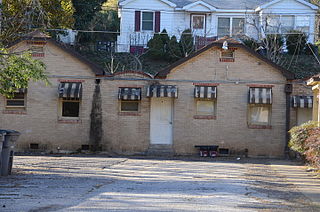
The Bellaire Court Historic District encompasses a former tourist court cottage complex at 637 Park Avenue in Hot Springs, Arkansas. The complex was built in the 1930s, when the advent of vacation travel by automobile rose to prominence. The complex is roughly L-shaped, with a long leg of the L perpendicular to the road, and the short leg at the rear, facing Magnolia Street. It is a single story structure with Craftsman styling, built out of wood and finished in stone veneer and brick trim. At the front of the complex is a manager's house, with cottage-style units lined behind it, each with a space that was originally a garage, but has since been filled in as part of a conversion to full-time residential units.

The Jeffries House is a historic house at 415 Skyline Drive in North Little Rock, Arkansas. It is a 2 1⁄2-story wood-frame structure, finished in a fieldstone veneer, and is three bays wide, with a side-gable roof, end chimneys, and symmetrical single-story wings at the sides. The house is distinctive as a fine example of Colonial Revival architecture, rendered in the unusual veneered stone finish. Built in 1931 by the Justin Matthews Company, it was the last house Matthews built in the Edgemont subdivision before the Great Depression brought the development to an end.

The Bates Tourist Court is a historic traveler's accommodation on Fair Street in Marshall, Arkansas. The property includes four buildings, three of which are stone-veneered wood frame cabins. The fourth building, which original housed the office, has been substantially altered since the facility was built about 1935. The property is rare within Searcy County as a surviving example of 1930s road-based tourist architecture.

The Walter Gray House is a historic house in rural southeastern Stone County, Arkansas. It is located on the Melrose Loop, about 0.5 miles (0.80 km) south of Arkansas Highway 14 between Locust Grove and Marcella. It is a single-story dogtrot house with an addition to its rear. It is a wood frame structure with weatherboard siding, with a hip-roof porch extending across its front facade, supported by chamfered posts. At its west end is a chimney built out of square pieces of sawn stone, laid to present a veneer-like facade. An L-shaped porch wraps around the rear addition. The house was built in 1910 by Walter Gray, a local farmer, and represents the continued use of this traditional form of architecture into the 20th century.

The Charley Passmore House is a historic house on Campus Street in Marshall, Arkansas. It is a 1-1/2 story wood frame structure, finished with masonry veneer, gable roof, and stone foundation. A single-story porch extends across the front, supported by piers of brick and stone joined by arched spandrels. A gabled dormer projects from the roof above the porch. The house was built in 1938, and is an excellent local example of Craftsman architecture executed primarily in stone and brick.

The Dennis and Christine Garrison House is a historic house at 105 Garrison Road in Greenbrier, Arkansas. It is a single story frame structure, finished in a veneer of stone and brick in 1951 by Silas Owens, Sr., a local master mason. The house has a number of hallmarks of Owens' work, including cream brick trim around the building corners and the openings of doors and windows, and an arched entrance porch. The herringbone patterns in the stonework are also an Owens signature. The chimney, with similar styling, was added by Owens' son Silas Jr.
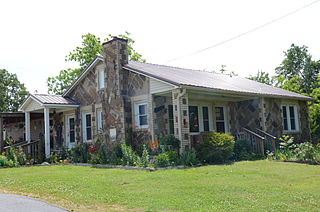
The Farris and Evelyn Langley House is a historic house at 12 Langley Lane in Republican, Arkansas. It is a rectangular frame house, its exterior finished in stone veneer with cream-colored brick trim. A gabled roof covers the house, extending over a recessed entry porch, its corner supported by a brick post. The ranch-style house was built in 1956 by Silas Owens, Sr., a mason noted regionally for his distinctive style. Hallmarks of his style are evident in this house, including the cream brick, and angled placement of the stones on the building's larger surfaces.
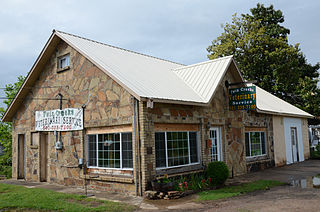
The Lee Service Station is a historic commercial building at 28 South Broadway in Damascus, Arkansas. It is a single-story frame structure with a cross-gable roof configuration, its exterior finished in stone veneer with brick trim. It has a single former garage bay on the right side, the bay opening now enclosed with a pedestrian door at its center. To its left is an office space, with a center entrance flanked by a large multi-pane windows. Door and window openings are trimmed in brick laid in a three-in, three-out pattern, and the stone veneer is in a herringbone pattern. These design elements are all signatures of the builder, Silas Owens, Sr., the master mason who finished the exterior about 1940. The building served as an automobile filling and service station through the 1950s, and has since seen a variety of other commercial uses.

The South Main Street Apartments Historic District encompasses a pair of identical Colonial Revival apartment houses at 2209 and 2213 Main Street in Little Rock, Arkansas. Both are two-story four-unit buildings, finished in a brick veneer and topped by a dormered hip roof. They were built in 1941, and are among the first buildings in the city to be built with funding assistance from the Federal Housing Administration. They were designed by the Little Rock firm of Bruggeman, Swaim & Allen.
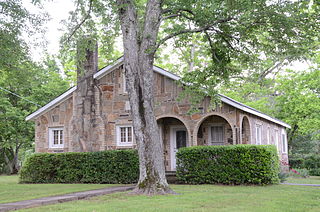
The Quattlebaum–Pelletier House is a historic house at 43 Ozark Street in Twin Groves, Arkansas. It is a single-story masonry structure, its exterior finished in a combination of fieldstone veneer and cream-colored brick. Built in 1942, it has many of the hallmarks of the work of Silas Owens Sr., a regionally prominent African-American mason, including an arcaded recessed porch, and the types of exterior materials used. Owens departed from his usually herringbone pattern for laying the stone on the walls, instead using longer and thinner sandstone in a geometric pattern.

The James and Jewell Salter House was a historic house at 159 South Broadview in Greenbrier, Arkansas. It was a single-story wood frame structure, finished in stone veneer with cream-colored brick trim elements. It was built about 1945, its exterior masonry done by Silas Owens, Sr., a regionally prominent African-American stonemason. It was unusual among Owens's works as an example of English Revival architecture done with his stylistic touches.
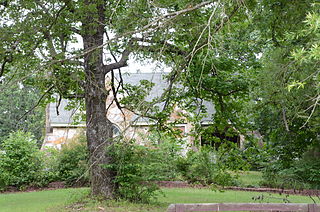
The Tyler–Southerland House is a historic house at 36 Southerland Road in Conway, Arkansas. It is a single-story wood-frame structure, with a gable roof and stone veneer exterior. Trim consists of cream-colored brick; both it and the veneer pattern are hallmarks of the work of Silas Owens Sr., a regionally prominent African-American mason. The house was built about 1948, and is a comparatively high style example of Owens's work. It has Tudor Revival styling, including a small gable over the front entry, and a large gable over a band of windows. Angled wing walls, an unusual feature not found in most of Owens's houses, flank the main entrance.

The Earl and Mildred Ward House is a historic house at 1157 Mitchell Street in Conway, Arkansas. It is a single story wood frame structure, with a stone veneer exterior, cream-colored brick trim, and a gabled roof. A gabled porch projects from the center of the modest house, with an arched opening lined with bricks. The house was built in 1949 by African-American mason Silas Owens, Sr., and is the only house he is known to have done in granite instead of his preferred sandstone.
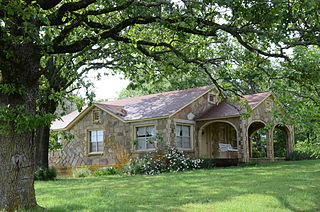
The Melvin Chrisco House is a historic house at 237 Alvin Brown Road in Damascus, Arkansas. It is a single-story wood frame structure, with a gabled roof and an exterior of stone veneer with cream-colored brick trim. A multi-arched gabled-roofed porch shelters the front entrance. The house was built in 1947, its exterior finished by the regionally prominent African-American mason Silas Owens, Sr. It exhibits hallmarks of Owens's work, including herringbone patterning in the stone work, arched porch openings, and the use of cream brick in quoined patterns on corners and openings.

The Carl and Esther Lee House is a historic house at 17493 United States Route 65 West in Damascus, Arkansas. It is a 1-1/2 story wood frame structure, with a stone veneer exterior and cream-colored brick trim. The front facade has projecting gable sections, with a porch sheltered by one such section with curved-arch openings. The larger gables have sunburst brick designs near their peaks. The house was built about 1948; the exterior stonework was done by Silas Owens, Sr., a regionally prominent stonemason. The house exhibits many of Owens's hallmarks, including the use of cream-colored brick, herringbone-patterned stonework, and arched openings.

The Evelyn Gill Walker House is a historic house at 18 South Spruce Street in Paris, Arkansas. Built by mason Tolbert E. Gill over a several-year period beginning in 1938, it is a distinctive example of Gill's Rustic style, with a stone veneer exterior and decorative components. It has a 1-1/2 story gabled main section, with a flat-roof porch in front, and a flat-roof ell in the rear. The ell features a turret with a bell-cast top, with a surrounding curved staircase leading to an open deck on the ell's roof.






















